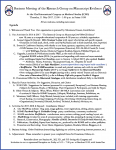2021 International Congress on Medieval Studies Call for Papers
July 13, 2020 in ICMS, International Congress on Medieval Studies, Societas Magica, Uncategorized
Research Group on Manuscript Evidence
at the 56th International Congress on Medieval Studies
(13–16 May 2021)
Call for Papers
Proposals Due by 15 September 2020
[Posted on 13 July 2020, with updates]
After the cancellation of the 2020 Congress, the preparations now for the 2021 Congress permit re-submitting the sessions which had been designed to take place in May 2020. By popular request, we performed that re-submission for all 5 Sessions. With approval now by the Congress Committee, we announce the Call for Papers. This announcement augments the brief listings of all Sessions on call on the Congress website. #kzoo2021.
Update: 5 August 2020:
Please note these updated instructions for submission of proposals for papers. New for this year, all such submissions must be made through the Confex system, as directed on the Congress website. However, the Congress’s plans for Session Organizers to access any proposals were overly optimistic. Exploring this problem, we have now learned that it is uncertain when (or if?) such access would be enabled. So we ask that, when you submit your proposal by that method as required, you inform the Session Organizer as well. Here we list each Session’s Organizer and contact address.
Sorry for the inconvenience, not of our making.
Perhaps an easy way of informing the Organizer of your proposal would be to forward thence the confirmation email which the Confex system would send for your completed proposal (title, abstract, contact information). We look forward to hearing from you.
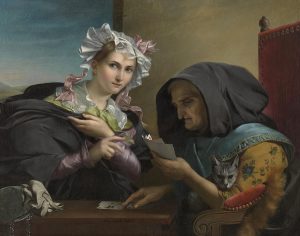
Adèle Kindt (1804–1884), The Fortune Teller (circa 1835). Antwerp, Koninklijk Museum voor Schone Kunsten. Image via Wikimedia Commons.
The Plan We Had for the 2020 Congress
The Announcement for our Sessions and other Activities at the 2020 Congress describes what we planned. Note that we published the Abstracts of Papers, so as to record the intentions of speakers for their presentations. The Abstracts are accessible both through that Announcement and through the Indexes of Abstracts by Year and by Author.
Our tradition regularly has been to post on our website the Abstracts before the Congress, as a foretaste of the Menu. Years ago, as a sign of appreciation, we adopted the custom of posting the Abstract of one or other contributor who became unable to attend to present in person (as with the 2016 Congress and the 2014 Congress). Thus we honor the intentions of our participants to present the results (or interim results) of their research and reflections, even when they could not do so at the event.
The Papers and their sequences within the intended Sessions were selected through the responses to the 2020 Call for Papers, which described the aims of the individual Sessions, both sponsored by the Research Group on Manuscript Evidence (3 Sessions), and co-sponsored with the Societas Magica (2 Sessions). The 2020 Congress would have been the 16th year of this co-sponsorship at the International Congress on Medieval Studies.
Like the 2015–2019 Congresses, we also planned for
- an Open Business Meeting and
- a co-sponsored Reception.
Even so, the Agenda for the postponed 2020 Business Meeting is available. It takes into account the changes for Spring 2020:
The Plan for 2021
We contemplate a similar or suitably revised approach to the 2021 Congress, conditions permitting.
For the 2021 Congress, we aim to re-present the Sessions, and we invite proposals for Papers or Responses.
The sponsorship and co-sponsorship remains as before — with only 1 change. For 2021, the Societas Magica has agreed to co-sponsor 1 of the Sessions which the RGME sponsored on its own in 2020: “Prologues in Medieval Texts of Magic, Astrology, and Prophecy”. Now with an adapted title, this Session now joins the already co-sponsored pair of sessions dedicated to “Revealing the Unknown I–II”. The 2021 Congress will be the 17th year of our co-sponsorship with the Societas Magica, in a constructive partnership of friends, students, and colleagues.
Call for Papers
We invite all our Speakers intended for the 2020 Congress to propose their papers again, with revisions if wished, according with the passage of time, developments in research, and the theme of the session.
We also invite others to propose contributions. After the close of the deadline for the Call for Papers, the updated Programs for the sessions will be selected, so as to allow for adaptations as appropriate.
This year marks a change for how proposals are to be made. As described on the Congress website, “the process for proposing papers and other contributions to congress sessions” involves “an online submission system powered by Confex”.
Please make your proposal through its “Submission Portal” for Submissions for the 2021 Congress. There you can find the individual Session in the listings under “Session of Papers”. Please also inform the Session Organizer as well, by the contact address supplied here. The deadline is 15 September 2020.
Our Sessions
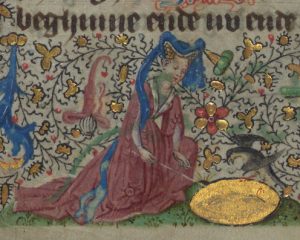
Baltimore, The Walters Art Museum, MS W.782, folio 15r. Van Alphen Hours. Image via Creative Commons.
Our events at the Congress, as always, are designed to represent, to explore, to promote, to celebrate, and to advance aspects of our shared range of interests, fields of study, subject matter, and collaboration between younger and established scholars, teachers, and others, in multiple centers.
Again we co-sponsor Sessions with the Societas Magica (3 Sessions this year). It will be the 17th year of this co-sponsorship.
Also, like the 2015–2019 Congresses, we plan for
- an Open Business Meeting and
- a co-sponsored Reception.
For the 2016–2018 Congresses, we co-sponsored a Reception with the Index of Medieval Art at Princeton University (formerly the Index of Christian Art), and we had planned a similar co-sponsored Reception in 2020. We explore plans for a 2021 Reception.
Background and Foreground
Glimpses of our co-sponsored Receptions at the Congress appear in the souvenirs of our Celebrations and in the Reports for the individual Congresses
The Agendas for our Open Business Meetings are available for your inspection and perusal:
These 1-page statements serve as concise Reports for our Activities, Plans, and Desiderata. Some of these Agendas now stand among the Top 5 Most Popular Downloads on our site.
 The most popular downloads still remain our copyright and FREE multilingual digital font Bembino, and some Booklets from our Symposia and Colloquia. So far, those “best sellers” — they are FREE — include:
The most popular downloads still remain our copyright and FREE multilingual digital font Bembino, and some Booklets from our Symposia and Colloquia. So far, those “best sellers” — they are FREE — include:
- From Cover to Cover (2020 Spring Symposium as planned)
- The Roads Taken (2019 Anniversary Symposium)
- Words & Deeds (2016 Symposium)
- When the Dust Has Settled (2014 Colloquium)
- Crusading and the Byzantine Legacy and The Medieval Balkans as Mirror (two of our 2016 Congress Sessions)
- Predicting the Past (one of our 2015 Congress Sessions).
These publications, like most of our Publications, are FREE, but we welcome donations, both in funds and in kind, for our nonprofit mission, with the option of tax-deduction for your Donations.
We look forward to your contributions.
*****
Call for Papers for the 2021 Congress
5 Sessions
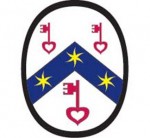 I. Sponsored by the Research Group on Manuscript Evidence
I. Sponsored by the Research Group on Manuscript Evidence
Sessions 1–2
1–2. Seal the Real: Documentary Records, Seals & Authentications
Part I. Signed & Sealed
Part II. × Marks the Spot
Organizer
Mildred Budny (Research Group on Manuscript Evidence)
director@manuscriptevidence.org

Judgment of Arbitration by Philip I, Count of Savoy, of 28 May 1275
with Brown Wax Seal
and with Docketing in French. Photograph by Mildred Budny.
These session explore the presentation and attestation of documentary records in the medieval and early modern periods, in the long transition to the modern custom of signatures as autographs — as distinct (partly) from earlier ‘signatures’ often made by proxy, whether by cross-signs, names inscribed by others on behalf of the signatory, personal or official seals, or other forms. The fields of consideration include forgeries (‘signatures’, seals, and questionable documents), reported records of documents perhaps otherwise lost (as in cartularies, chronicles, and other narratives), and the occasional preservation of fingerprints upon the records themselves.
The time-honored human determination to establish recognized — that is, effective — modes of authenticating intentions and actions by individuals and institutions alike underpins the historical transmission (or disruption, willful and otherwise) of formal records of agreements, sales, transfers, decisions over grievances and feuds, and other impactful official arrangements across the centuries. Examining case studies for this session, we encourage multiple approaches, subject matters, and methodologies for analyzing the strategies adopted (successfully or otherwise) in the pursuit of such a quest for authentication.
The desire effectively to express identity and authenticity as a matter of record may well resonate with many participants. The Session considers aspects of the historical traditions, improvisations, inventions, and (it may be) occasional failures of earlier centuries in such a quest. Perchance we might learn instructively from the past.
Part I: Signed & Sealed
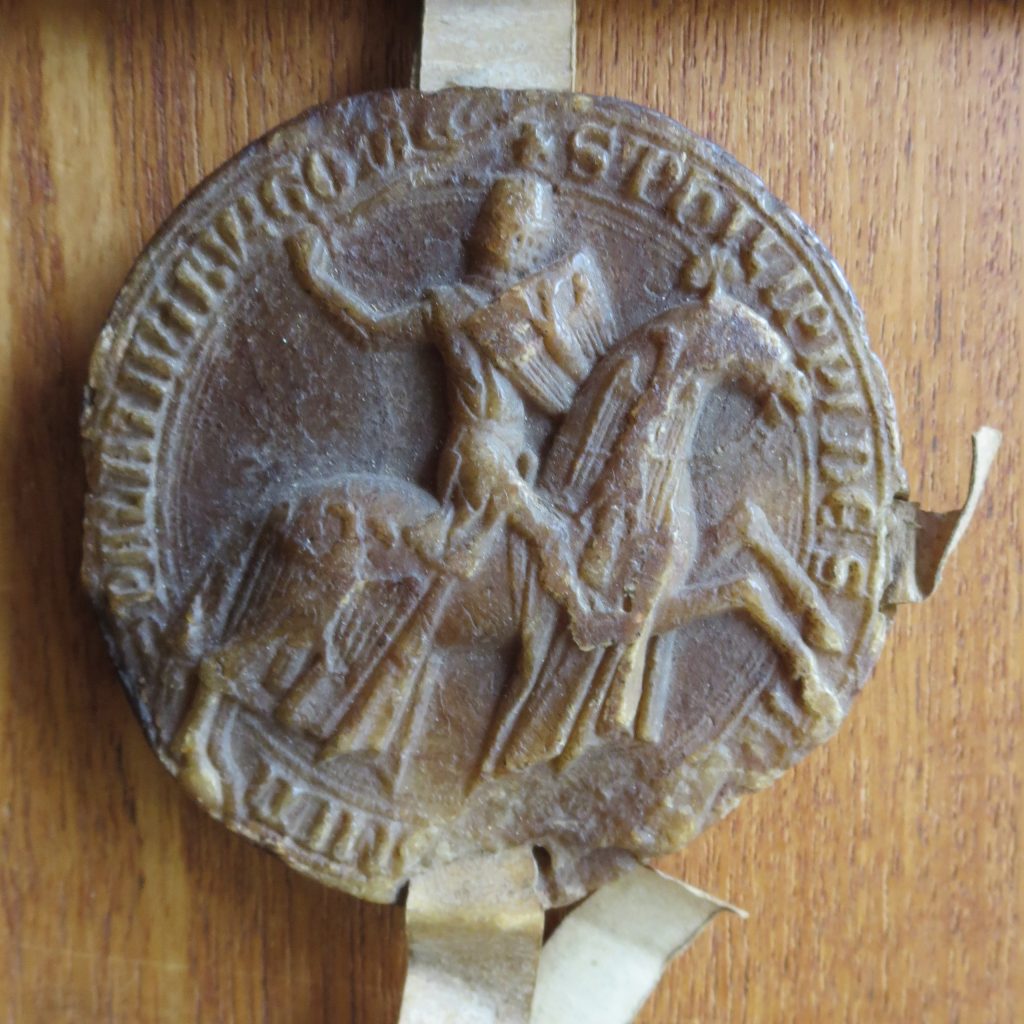
Equestrian Wax Seal of Philip I, Count of Savoy,
Affixed to his Judgment of Abritration, 28 May 1275. Photograph by Mildred Budny.
Part II: × Marks the Spot
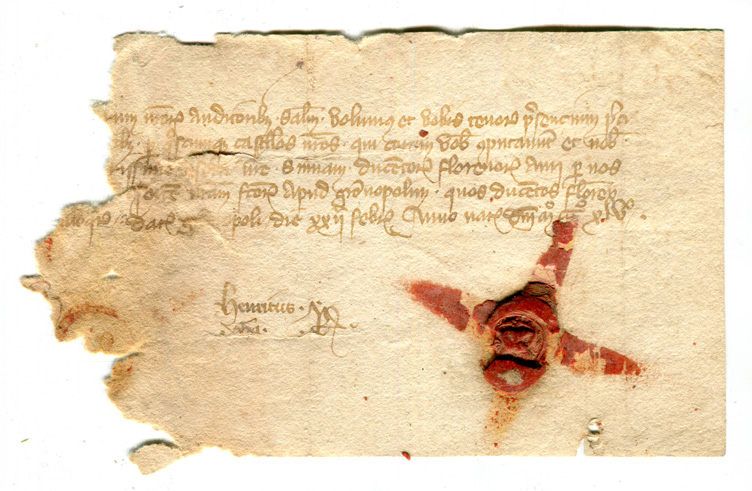
Document in 5 lines on paper, dated 22 February 1345 (Old Style), with red wax seal.
Please send your Proposals by 15 September 2020 via Submissions for the 2021 Congress.
Please also inform the Session Organizer as well. Perhaps an easy way of informing the Organizer of your proposal would be to forward the confirmation email which the Confex system would send for your completed proposal (title, abstract, contact information).
Also, see our blog for on-going discoveries in the study of documents, seals sometimes included:
Manuscript Studies. See its Contents List.
II. Co-Sponsored with the Societas Magica
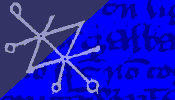 Sessions 3–5
Sessions 3–5
Session 3. Medieval Magic in Theory:
Prologues to Learned Texts of Magic
Organizer
Vajra Regan (Centre for Medieval Studies, University of Toronto)
vajra.regan@utoronto.ca
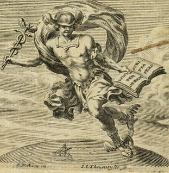
Hermes Trismegistus. Frontispiece image (Lyons, 1669) via Wikimedia Commons and Wellcome Images.
The prologues to medieval texts of learned magic could serve a variety of functions. They were a space for their authors to announce the theme of the work, to situate the work within a specific literary, philosophical, or theological landscape, and to lay special claim to the reader’s attention. Consequently, these prologues have much to tell us about the traditions and beliefs underlying certain magical texts. Moreover, because many magical texts are substantially anonymous compilations, their prologues often provide unique access to the lives and contexts of the men and women behind the parchment.
The aim of this session is to explore these still largely understudied prologues which testify to the variety of medieval approaches to ‘magic’. We are especially interested in how magic is theorized in these prologues. What insights do these prologues offer into contemporary debates about the epistemological status of magic? Moreover, what can they tell us about the social, religious, and institutional contexts of their authors and readers?
Pdf for this proposal here.
Please send your Proposals by 15 September 2020 via Submissions for the 2021 Congress.
Please also inform the Session Organizer as well. Perhaps an easy way of informing the Organizer of your proposal would be to forward the confirmation email which the Confex system would send for your completed proposal (title, abstract, contact information).
Sessions 4–5: Revealing the Unknown, Parts I–II
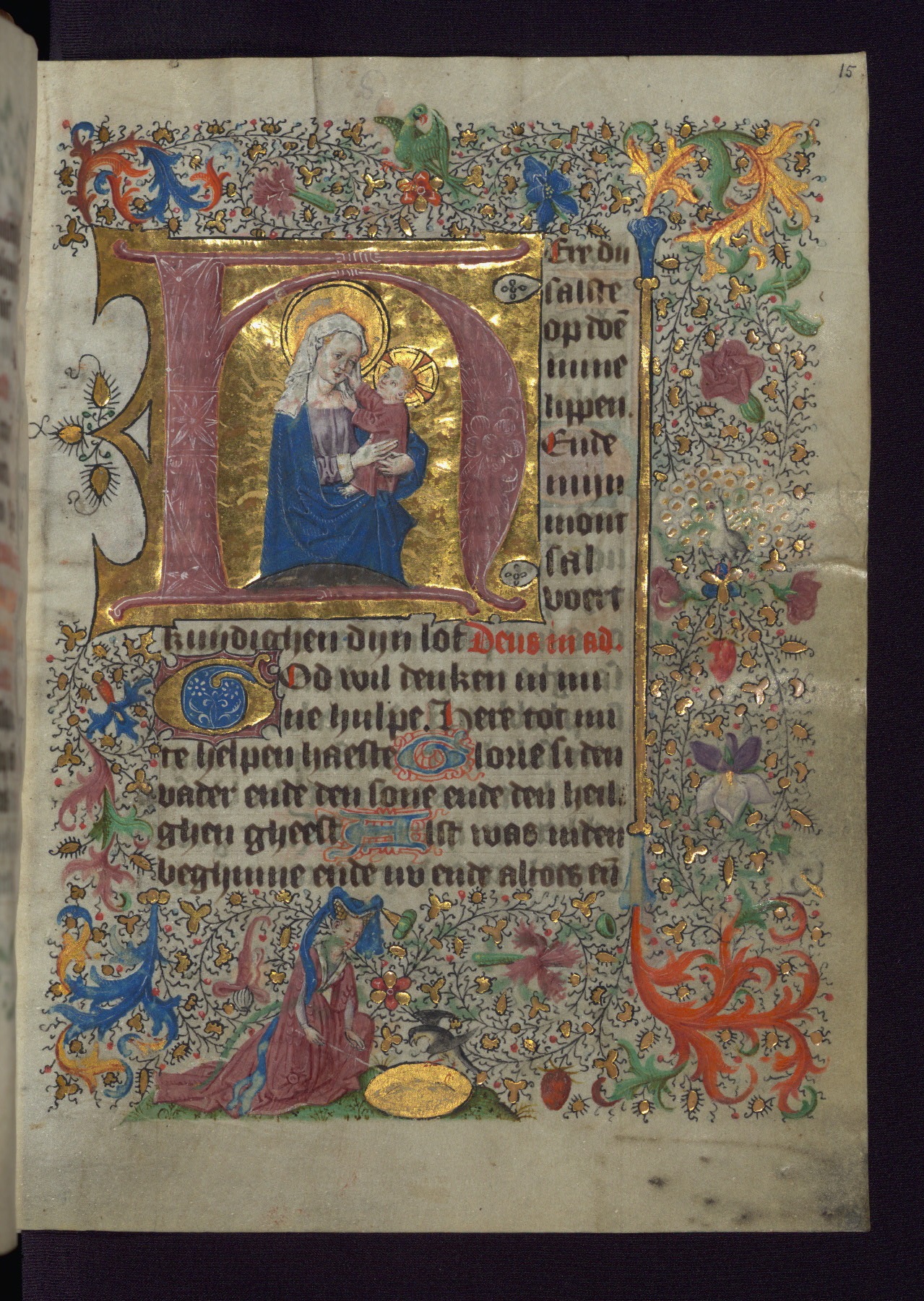
Baltimore, The Walters Art Museum, MS W.782, folio 15r. Van Alphen Hours. Dutch Book of Hours made for a female patron in the mid 15th century. Opening page of the Hours of the Virgin: “Here du salste opdoen mine lippen”. Image via Creative Commons.
4. Revealing the Unknown I:
Scryers and Scrying in the Middle Ages and Early Modern Period
Organizers
Sanne de Laat
English Department
Radboud University Nijmegen
sannede.laat@student.ru.nl
or by September:
S.p.a.m.de.laat@gmail.com
László Sándor Chardonnens
English Department
Radboud University Nijmegen
The Netherlands
From the little boy on the lap of the priest to the astrologer physician Richard Napier, scryers have fulfilled a significant role in spirit communications throughout the Middle Ages and early modern period. That children were instrumentalized by clergy doubling as ritual magicians has been known for a long time. The activities of professional adult scryers, such as Edward Kelley and Sarah Skelhorn, are likewise well-documented. Recently, however, attention has moved to the scrying activities of medical and astrological professionals, as Ofer Hadass’s study of Richard Napier bears out. The autobiography of William Lilly and the manuscripts of Elias Ashmole suggest that early modern astrologer physicians utilized scrying in different ways from the medieval clerical underworld.
This session offers an opportunity to reassess older notions about scryers and scrying, and to engage with current research on the identity and activities of professional scryers. Topics for papers could feature, for instance, the techniques used by scryers, the necessary instruments for this craft, as well as the goals for which a scryer’s services could be used. Diachronic approaches to the topic are welcome, and papers that consider cross-cultural approaches, such as Jewish or Arabic scryers and scrying practices, are encouraged.
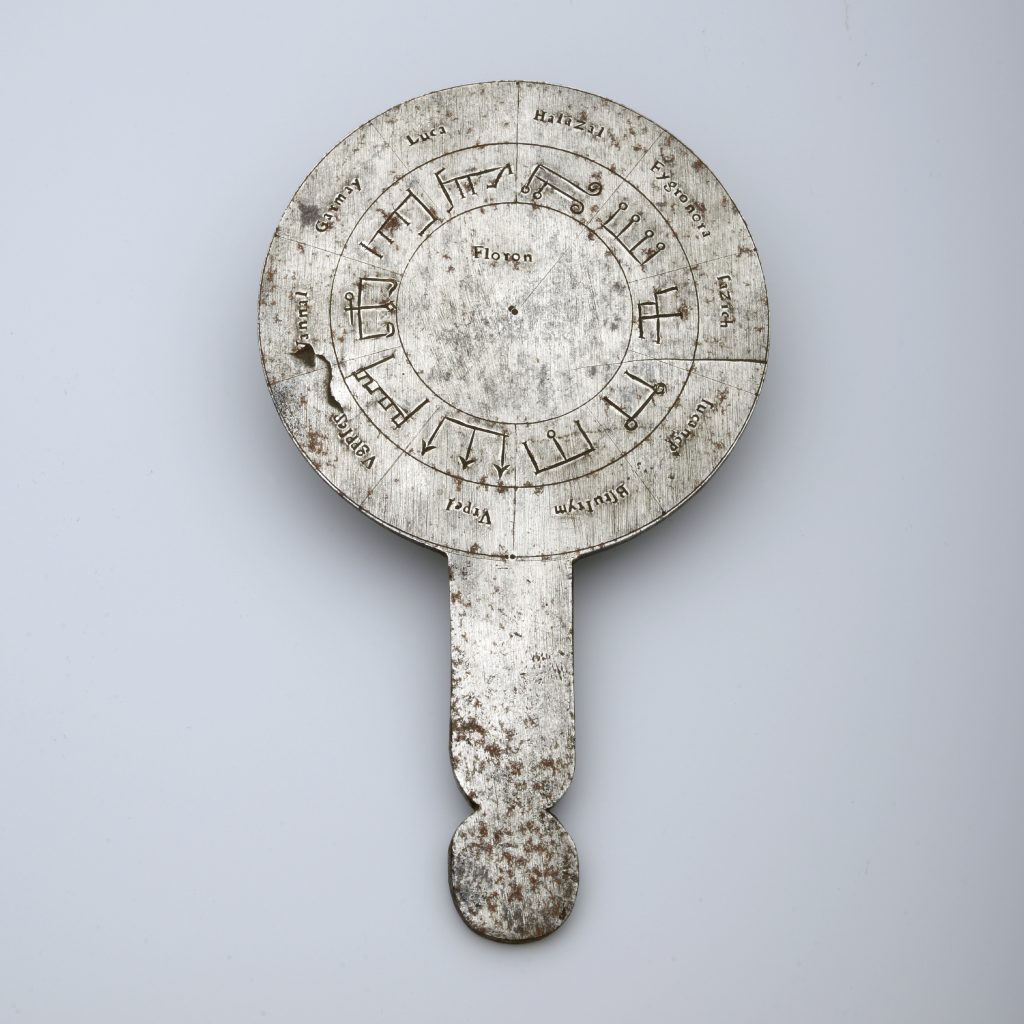
Magic mirror of Floron. Mathematisch-Physikalischer Salon, Staatliche Kunstsammlungen Dresden. Via Creative Commons.
Please send your Proposals by 15 September 2020 via Submissions for the 2021 Congress.
Please also inform the Session Organizer as well. Perhaps an easy way of informing the Organizer of your proposal would be to forward the confirmation email which the Confex system would send for your completed proposal (title, abstract, contact information).
5. Revealing the Unknown II:
Sortilège, Bibliomancy, and Divination
Organizer
Phillip A. Bernhardt-House (Skagit Valley College – Whitbey Island)
phillip.bernhardthouse@gmail.com
From earliest times, humans have sought methods to contact supernatural entities to obtain knowledge of the present or future, known as divination. In ancient and medieval contexts, two such methods that were sometimes connected were sortilège and bibliomancy: for example, the Lots of Mary, Sortes Astramphysychi, Homeric Oracles, and Virgilian Oracles.
These practices involved numerological processes to select specific passages from canonical texts in order to divine on desired topics. This session focuses on these and other methods of divination, so as to understand how textual and other authorities became invested with powers far greater than the impacts of their literary merits.
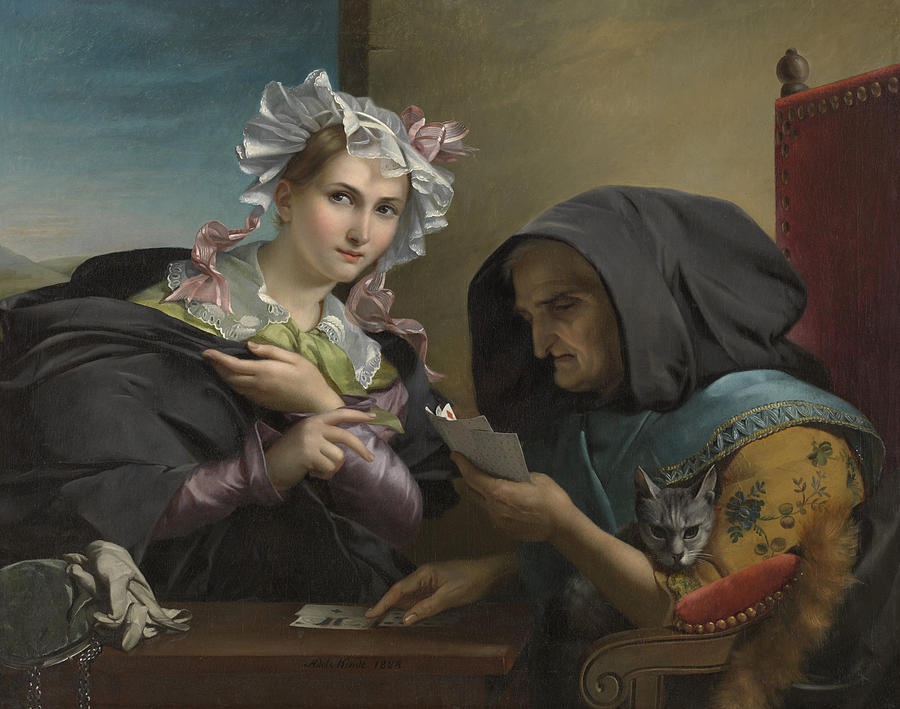
Adèle Kindt (1804–1884), The Fortune Teller (circa 1835), cat included. Antwerp, Koninklijk Museum voor Schone Kunsten. Image via Wikimedia Commons.
Please send your Proposals by 15 September 2020 via Submissions for the 2021 Congress.
Please also inform the Session Organizer as well. Perhaps an easy way of informing the Organizer of your proposal would be to forward the confirmation email which the Confex system would send for your completed proposal (title, abstract, contact information).
*****
For updates, please visit this site, our News & Views, and our Facebook Page .
Also, follow our blogs:
Please Contact Us with your questions and suggestions.
For our nonprofit educational mission, with tax-exempt status, donations in funds and in kind (expertise, materials, time) are welcome. Join us!

*****

